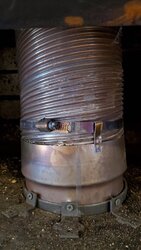I'd like to add a thermometer to my Osburn wood stove insert, but will have to use a thermocouple because the stove is set back into the fireplace and the flue is buried. That means I can't locate the sensor even a foot up the pipe, much less the recommended 18". Where would be best? Here's a picture, and the pipe is 6" in diameter.
I'm thinking of using a thermocouple with a washer on the end and screwing it into the collar somewhere to measure surface temps.
Thanks.

I'm thinking of using a thermocouple with a washer on the end and screwing it into the collar somewhere to measure surface temps.
Thanks.



